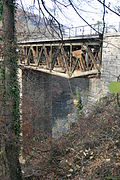Wettingen – Baden railway bridge
Coordinates: 47 ° 27 '49 " N , 8 ° 18' 33" E ; CH1903: six hundred and sixty-five thousand six hundred and twenty-eight / 257344
| Lower Limmat Bridge | ||
|---|---|---|
| use |
|
|
| Crossing of | Limmat | |
| place | Wettingen , Baden AG | |
| overall length | 133.4 m | |
| Number of openings | 3 | |
| Longest span | 41.2 m + 51 m + 41.2 m | |
| height | 33 m | |
| location | ||
|
|
||
The Wettingen – Baden railway bridge (also known as the Lower Limmat Bridge ) was completed in 1877. It was built on behalf of the Swiss Northeast Railway (NOB) and the Swiss National Railway ( SNB), runs on three tracks over the Limmat , with two tracks serving the Zurich – Baden railway line , where the bridge between the Wettingen and Baden stations is, and the third track the Zofingen – Wettingen railway line , where the nearest train station is Baden Oberstadt. The river here is also the municipality boundary between Baden and Wettingen .
history
The Lower Limmat Bridge was put into operation in 1877 and replaced the route along the western bank of the Limmat, as it turned out to be unsuitable due to violent landslides. The original route of the Northern Railway ran along the left bank of the Limmat, whereby the route crossed a creeping slope , which made it necessary to maintain the route more. The community of Wettingen was bypassed without a train station. In connection with the planned route expansion, a route relocation was planned in the area, which also opened up the village of Wettingen with a train station. In addition to the Zofingen Winterthur SNB line, the NOB also planned the Bülach-Baden Railway , which should end here. The relocation was done by stretching the old route and crossing the Limmat loop near Wettingen Monastery with two bridges, the one described here being the more northerly. Wettingen station was built on the area between the monastery and the village. The Lower Limmat Bridge began in 1875, i.e. after the Upper Limmat Bridge was completed.
construction
First bridge (1875-1922)
| First bridge (1875-1922) | |
|---|---|
| construction | Lattice girders on masonry piers |
| building-costs | 660,000 francs |
| start of building | 1875 |
| opening | 1877 |
| Status | replaced |
| Construction work | Union, AG for mining, iron and steel industry , Dortmund |
| closure | 1922 |
The first bridge consisted of three single-lane, riveted lattice girders with an overhead carriageway, as was common in the 1860s. This steel construction rested on two pillars and the two abutments , which are made of granite masonry and are still used in today's building. The tracks were laid on the iron structure. The height of the roadway above the river was 33 meters with the Limmat flowing in the middle. The total weight of the bridge was 660 t and the construction costs amounted to 660,000 francs . The total length is 133.4 m; the individual spans 41.2 m, 51.0 m, 41.2 m. The height above the mean river water 33.0 m. The construction was carried out by the Union, AG for mining, iron and steel industry in Dortmund .
Second bridge (1922-today)
| Second bridge (1922-today) | |
|---|---|
| construction | Truss on masonry pillars |
| building-costs | 660,000 francs |
| opening | 1922 |
| Status | in operation |
| Construction work |
|
The first bridge construction was replaced in 1922 by a new building of a similar construction. For this purpose, the new iron construction with riveted trusses was erected next to the bridge, which was then pushed between the old abutments. The total weight of the bridge increased to 1170 t. Since then there has been a pedestrian walkway next to the three tracks.
The second bridge from 1922 was built by Wartmann, Vallette and Cie in Brugg , Buss AG in Basel , Löhle and Kern AG in Zurich and Conrad Zschokke AG in Döttingen . In contrast to the previous building, the three single-lane trusses are designed with simple struts and a stepped pedestrian walkway. The weight is 3 × 390 t, i.e. 1170 t. A special feature is the building in which the individual steel boxes were constructed from the outside and then pushed to their final position in order to be able to continue to operate on two tracks. It is considered to be the largest bridge displacement in Switzerland at the time.





